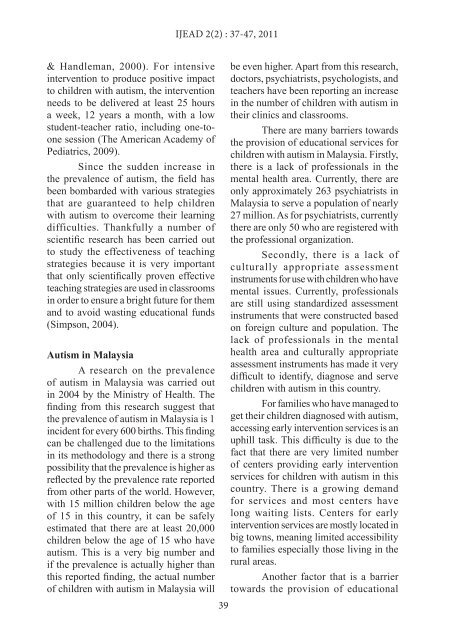Experience and Challenges in Setting up a Model - Mahasarakham ...
Experience and Challenges in Setting up a Model - Mahasarakham ...
Experience and Challenges in Setting up a Model - Mahasarakham ...
You also want an ePaper? Increase the reach of your titles
YUMPU automatically turns print PDFs into web optimized ePapers that Google loves.
& H<strong>and</strong>leman, 2000). For <strong>in</strong>tensive<br />
<strong>in</strong>tervention to produce positive impact<br />
to children with autism, the <strong>in</strong>tervention<br />
needs to be delivered at least 25 hours<br />
a week, 12 years a month, with a low<br />
student-teacher ratio, <strong>in</strong>clud<strong>in</strong>g one-toone<br />
session (The American Academy of<br />
Pediatrics, 2009).<br />
S<strong>in</strong>ce the sudden <strong>in</strong>crease <strong>in</strong><br />
the prevalence of autism, the field has<br />
been bombarded with various strategies<br />
that are guaranteed to help children<br />
with autism to overcome their learn<strong>in</strong>g<br />
difficulties. Thankfully a number of<br />
scientific research has been carried out<br />
to study the effectiveness of teach<strong>in</strong>g<br />
strategies because it is very important<br />
that only scientifically proven effective<br />
teach<strong>in</strong>g strategies are used <strong>in</strong> classrooms<br />
<strong>in</strong> order to ensure a bright future for them<br />
<strong>and</strong> to avoid wast<strong>in</strong>g educational funds<br />
(Simpson, 2004).<br />
Autism <strong>in</strong> Malaysia<br />
A research on the prevalence<br />
of autism <strong>in</strong> Malaysia was carried out<br />
<strong>in</strong> 2004 by the M<strong>in</strong>istry of Health. The<br />
f<strong>in</strong>d<strong>in</strong>g from this research suggest that<br />
the prevalence of autism <strong>in</strong> Malaysia is 1<br />
<strong>in</strong>cident for every 600 births. This f<strong>in</strong>d<strong>in</strong>g<br />
can be challenged due to the limitations<br />
<strong>in</strong> its methodology <strong>and</strong> there is a strong<br />
possibility that the prevalence is higher as<br />
reflected by the prevalence rate reported<br />
from other parts of the world. However,<br />
with 15 million children below the age<br />
of 15 <strong>in</strong> this country, it can be safely<br />
estimated that there are at least 20,000<br />
children below the age of 15 who have<br />
autism. This is a very big number <strong>and</strong><br />
if the prevalence is actually higher than<br />
this reported f<strong>in</strong>d<strong>in</strong>g, the actual number<br />
of children with autism <strong>in</strong> Malaysia will<br />
IJEAD 2(2) : 37-47, 2011<br />
39<br />
be even higher. Apart from this research,<br />
doctors, psychiatrists, psychologists, <strong>and</strong><br />
teachers have been report<strong>in</strong>g an <strong>in</strong>crease<br />
<strong>in</strong> the number of children with autism <strong>in</strong><br />
their cl<strong>in</strong>ics <strong>and</strong> classrooms.<br />
There are many barriers towards<br />
the provision of educational services for<br />
children with autism <strong>in</strong> Malaysia. Firstly,<br />
there is a lack of professionals <strong>in</strong> the<br />
mental health area. Currently, there are<br />
only approximately 263 psychiatrists <strong>in</strong><br />
Malaysia to serve a population of nearly<br />
27 million. As for psychiatrists, currently<br />
there are only 50 who are registered with<br />
the professional organization.<br />
Secondly, there is a lack of<br />
culturally appropriate assessment<br />
<strong>in</strong>struments for use with children who have<br />
mental issues. Currently, professionals<br />
are still us<strong>in</strong>g st<strong>and</strong>ardized assessment<br />
<strong>in</strong>struments that were constructed based<br />
on foreign culture <strong>and</strong> population. The<br />
lack of professionals <strong>in</strong> the mental<br />
health area <strong>and</strong> culturally appropriate<br />
assessment <strong>in</strong>struments has made it very<br />
difficult to identify, diagnose <strong>and</strong> serve<br />
children with autism <strong>in</strong> this country.<br />
For families who have managed to<br />
get their children diagnosed with autism,<br />
access<strong>in</strong>g early <strong>in</strong>tervention services is an<br />
<strong>up</strong>hill task. This difficulty is due to the<br />
fact that there are very limited number<br />
of centers provid<strong>in</strong>g early <strong>in</strong>tervention<br />
services for children with autism <strong>in</strong> this<br />
country. There is a grow<strong>in</strong>g dem<strong>and</strong><br />
for services <strong>and</strong> most centers have<br />
long wait<strong>in</strong>g lists. Centers for early<br />
<strong>in</strong>tervention services are mostly located <strong>in</strong><br />
big towns, mean<strong>in</strong>g limited accessibility<br />
to families especially those liv<strong>in</strong>g <strong>in</strong> the<br />
rural areas.<br />
Another factor that is a barrier<br />
towards the provision of educational


